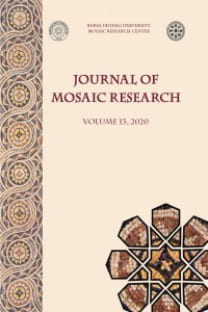Kibyra Odeion’unun Mozaik Yazıtları
Kibyra, Olympeion Odeion’u, mozaik, Asiarkhes, İS 243-254
The Mosaic Inscriptions of the Cibyran Odeion
Cibyra, Olympeion Odeion, mosaic, Asiarch, 243-254 AD,
___
- Alzinger 1974 W. Alzinger, Augusteische Architectur in Ephesos, Österreichischen Arcaeologischen Institut, Wien.
- Bailly 1935 A. Bailly, Dictionnaire Grec – Français, Hachette.
- Brandis 1896 K. G. Brandis, “Asiarches”, RE II Reihe 4, Halfband, Stuttgart, 1564-1578.
- Chapot 1904 V. Capot, La Province Romaine Proconsulaire D’Asie depuis ses Origines jusqu’à la Fin du Haut-Empire, Paris.
- Corsten 2002 Th. Corsten, Die Inschriften von Kibyra. Teil I, Die Inschriften der Stadt und ihrer näheren Umgebung, IK 60, Bonn.
- D’Andria 2003 F. D’Andria, Hierapolis, (çev. N. Fırat), İstanbul.
- D’Andria 2016 F. D’Andria, “MAIER-İtalyan Arkeoloji Heyetinin Hierapolis’teki Çalışmaları”, C. Polito’nun Ekiyle. F. D’Andria, M. P. Caggia - T. Ismaelli (eds.), Hierapolis di Frigia VIII, 1, Le Attivita Delle Campagne Di Scavo E Restauro 2007-2011, İstanbul, 25-34.
- Deininger 1965 J. Deininger, Die Provinziallandtage der Römischen Kaiserzeit, Berlin.
- Dimitriev 2005 S. Dimitriev, City Government in Hellenistic and Roman Asia Minor, Oxford.
- Friesen 1993 S. J. Friesen, Twice Neokoros: Ephesus, Asia and the Cult of the Flavian Imperial Family, Leiden.
- Friesen 1999a S. J. Friesen, “Asiarchs”, ZPE 126, 275-290.
- Friesen 1999b S. J. Friesen, “Highpriests of Asia and Asiarchs: Farewell to the Identification Theory”, P. Scherrer- H. Taeuber - H. Thür (eds.), Stein und Wege: Festschrift für Dieter Knibbe zum 65 Geburstag, Wien, 303-307.
- Kearsly 1986 R. A. Kearsley, “The Archiereiai of Asia and the Relationship of the Asiarch and the Archiereus of Asia”, GRBS 27, 183-192.
- Kılıç-Aslan 2018 S. Kılıç-Arslan, “Elite Lycian Families and Their Matrimonial Alliances with Distinguished Houses of Kibyra. Some Notes on an Honorary Inscription from Lydai”, M. Arslan – F. Baz (eds.), Arkeoloji, Tarih ve Epigrafi’nin Arasında: Prof. Dr. Vedat Çelgin’in 68. Doğum Günü Onuruna Makaleler, İstanbul, 501-512.
- Liddell – Scott 1883 H. G. Liddell – R. Scott, Greek-English Lexicon, New York.
- Macro 1979 A. D. Macro, „A Confirmed Asiarch“, AJP 100, 94-98.
- Magie 1950 D. Magie, Roman Rule in Asia Minor: To the End of the Third Century After Christ, I. – II, Princeton.
- Mehl 2003 A. Mehl, “Asiarchy”, BNP II, 158, Leiden.
- Özüdoğru 2020 Ş. Özüdoğru, Kibyra: Kibyra Maior/Caesarea Cibyra, Kibyra Kazı ve Araştırmaları Monografi Serisi I, İstanbul.
- Özüdoğru – Dökü 2012 Ş. Özüdoğru – E. Dökü, “Kibyra 2011 Yılı Çalışmaları”, 34. KST, 159-170.
- Özüdoğru – Tarkan 2018 Ş. Özüdoğru – D. Tarkan, “Kibyra Geç Antikçağ Hamamı”, Adalya 21, 175 – 210.
- ISSN: 1309-047X
- Yayın Aralığı: 1
- Başlangıç: 2008
- Yayıncı: Ululdağ Üniversitesi, Mozaik Araştırlmaları Merkezi
Roma Mozaiklerinde Ulysses ve Polyphemus’un Temsili. Analizler ve Karşılaştırmalar
Erdem’den Güce: Kadın Kahramanlığı Hakkında Keşifler - Lilian Broca Mozaikleri
Ve Dionysos Dalgalardan Yükseldi… Kabul Salonlarının Mozaikleri Üzerindeki Dionysos ve Deniz
Kitap İncelemesi: Corpus of the Roman Mosaics of the Conuentus Bracaraugustanus
Suriye’nin Kuzeyinde in situ Yeni Osrhoene Mozaikleri
Komait ABDALLAH, Alain DESREUMAUX, Mohamad AL-KAİD
Kibyra Odeion’unun Mozaik Yazıtları
Elif ALTEN GÜLER, Düzgün TARKAN
Antakya’dan Bir Mozaik Üzerinde Melek Kanatlı Psykhe
İsa’nın Mabede Takdimi Sahnesinin Görsel Anlatım Biçimleri Üzerine Bir Değerlendirme
Marina Maria Serena NUOVO, Silvia PRELL
